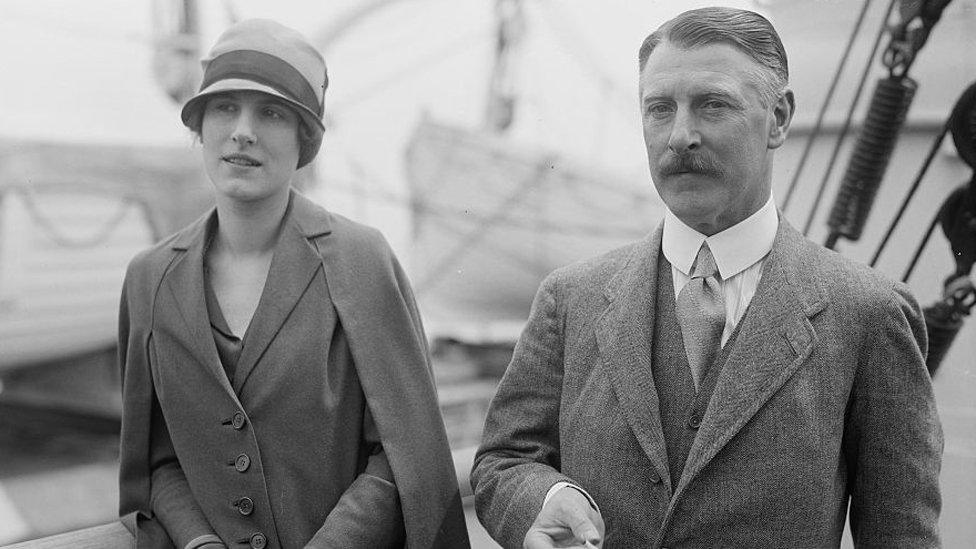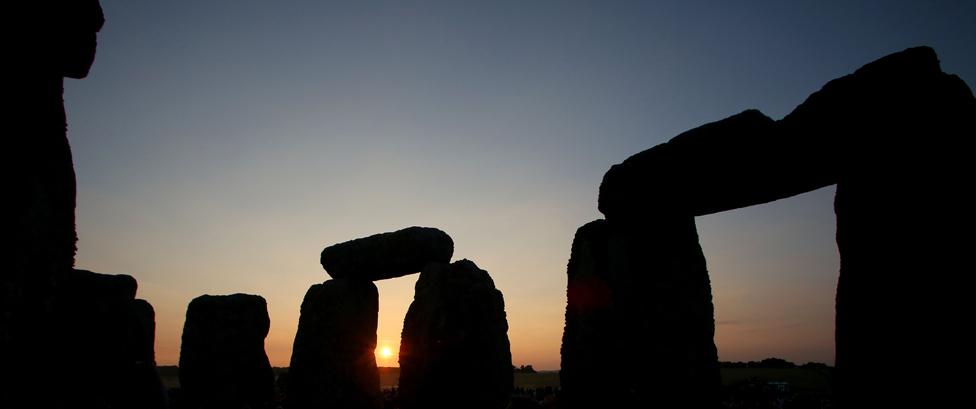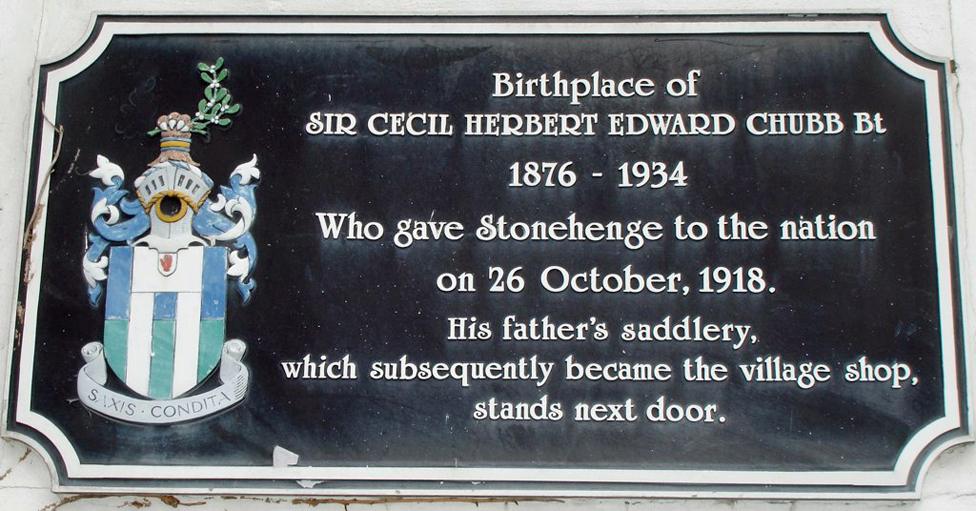The man who bought Stonehenge - and then gave it away
- Published

Today Stonehenge is England's most important monument, but 100 years ago it was up for sale. The man who bought it helped seal its fate.
Standing on Salisbury Plain, its stones visible from afar, Stonehenge has been a Unesco World Heritage Site, external since 1986 and attracts a million visitors a year.
So it's strange to think that England's most significant monument was once bought by a barrister as a present to his wife. Or so one theory goes. Another is that he feared a rich American might take it.
Whatever his motivation, 100 years ago, on 21 September 1915, Cecil Chubb paid £6,600 for the monument at an auction in Salisbury, Wiltshire. It happened, he said, "on a whim".
Chubb's wife Mary was reportedly less than grateful for the romantic gesture, possibly because the price equated to as much as £680,000 in today's money. "It's said that Mary wanted Cecil to buy a set of curtains at the auction," says Stonehenge's curator, Heather Sebire. "And he came back with something rather different."

Lady Mary and Sir Cecil Chubb on board the RMS Aquitania, 1926
On 26 October 1918, 16 days before the Armistice ended World War One, Chubb passed Stonehenge into public ownership, via a deed of gift, external.
The next year Prime Minister David Lloyd George recognised his generosity with a title, Chubb becoming Sir Cecil Chubb, First Baronet of Stonehenge.
To mark this Chubb had a coat of arms made up, bearing a silver lion's leg grasping two branches of mistletoe - a plant regarded as sacred by the druids who (people believed) worshipped at Stonehenge. The coat of arms, external bore the motto "Saxis Condita", meaning "Founded on the stones".
Chubb had come from humble origins. Born in 1876, his father was a saddler and harness-maker in the village of Shrewton, a few miles from Stonehenge.
He attended a grammar school, working his way, via a stint as a student teacher, to Cambridge University. He became a barrister and amassed a considerable fortune.
Chubb didn't forget his roots when he gave Stonehenge away. His deed of gift stipulated the public shouldn't pay "a sum exceeding one shilling" per visit. A separate agreement with the parish council said local people should get in for nothing.

The story of Stonehenge

Large-scale human activity first seen around site around 7000 BC; first large earthwork was built around 3100 BC and second stage of construction around 2150 BC
Third stage happened 150 years or so later, with the arrival of sandstones, probably from north Wiltshire, the largest weighing 50 tonnes - men dragged stones using sledges and leather ropes
Stones were arranged into the present horseshoe and circle shape around 1500 BC
Purpose of Stonehenge remains mystery - suggestions include royal burial ground, temple, site for human sacrifices, or building capable of predicting eclipses
Site is aligned so sun shines through to particular point on summer and winter solstices, but no academic consensus over why prehistoric Britons thought this important

Now run by English Heritage, some 30,000 people living near Stonehenge still get free entry. But, for outsiders, an adult's ticket, external is £14.50. English Heritage argues that, given wage inflation over the past century, it costs less in real terms today than it did then.
The reason Stonehenge and a 30-acre triangle of adjoining land came on to the market in 1915 was the death of Sir Edmund Antrobus, the only male heir of the family who had owned it since the 1820s. A lieutenant in the Grenadier Guards, he had been killed in Kruiseik, Belgium, in October 1914, during one of the first battles of World War One.
Perhaps this sad tale, as much as love for Mary or a desire to be rewarded for good works, motivated Chubb to buy Stonehenge.
"I think there must have been a strong local element in Chubb's thinking, as he was from nearby," says Sebire. "It's not certain that he knew the Antrobus family, but he's likely to have known of them."
Ahead of the auction, there was speculation that a wealthy foreigner might buy Stonehenge, dismantle it and transport it abroad, as happened to London Bridge more than 50 years later, when it was shipped to Arizona.
In its preview story, the Daily Telegraph noted that the news of Stonehenge's sale was "enough to rouse the envy of all American millionaires who are bitten by the craze for acquiring antiques". Preventing this might have influenced Chubb's purchase.
"Cecil Chubb did a great thing in trying to return Stonehenge to the people and to ensure a legacy of free and unfettered access," says Frank Somers, of Stonehenge and Amesbury Druids. "I do not believe that this has been honoured by the authorities who have taken upon themselves the mantle of its guardians."

A plaque commemorates Sir Cecil's birthplace, along with his mistletoe-sporting coat of arms
Stonehenge had been privately owned since being confiscated from a nearby abbey during Henry VIII's reign. But by the time of Chubb's involvement, the duty of preservation was being more keenly felt.
The Ancient Monuments Act of 1913 allowed for the first time, external the compulsory purchase of historic sites. As World War One was coming to a close, officials would have more time to implement it. Stonehenge was an obvious candidate. In Chubb's mind it might have become a "liability", says Sebire. Even so, he gave it away rather than sell it.
Chubb died in 1934. His son, Sir John Chubb, died in 1957, leaving no heir, meaning the baronetcy ended there.
Few today have heard of Sir Cecil Chubb, but there is a plaque on the house where he was born and grew up in Shrewton.

The new visitor centre at Stonehenge
The area around Stonehenge is undergoing a £27m transformation. The A344 nearby has closed and the visitor centre and car park have been moved away from the stones. The fence surrounding the ruins is being pulled down.
In his gift of deed, Chubb asked for the site to remain as open as possible. A hundred years after he bought it, this appears to be happening.
But the druids say more needs to be done. "Families used to picnic at Stonehenge," says Somers. "Lovers met there beneath a full moon. Children would touch the ancient stones in wonder. Druids would gather to lead public and local events."
"Stonehenge for her part would embrace, inspire and nurture all those who visited with good intent," he adds. "Stonehenge has not lost her integrity but perhaps, in the modern age where money rules over everything, we have."
The stones remain in their majesty, any debate about their future being over access rather than preservation.
"I've been here when it's quiet, at different times of year," says Sebire. "It never ceases to impress. No one can really say why Chubb did what he did. You might say it's as mysterious as Stonehenge itself."

More from the Magazine


Subscribe to the BBC News Magazine's email newsletter, external to get articles sent to your inbox.